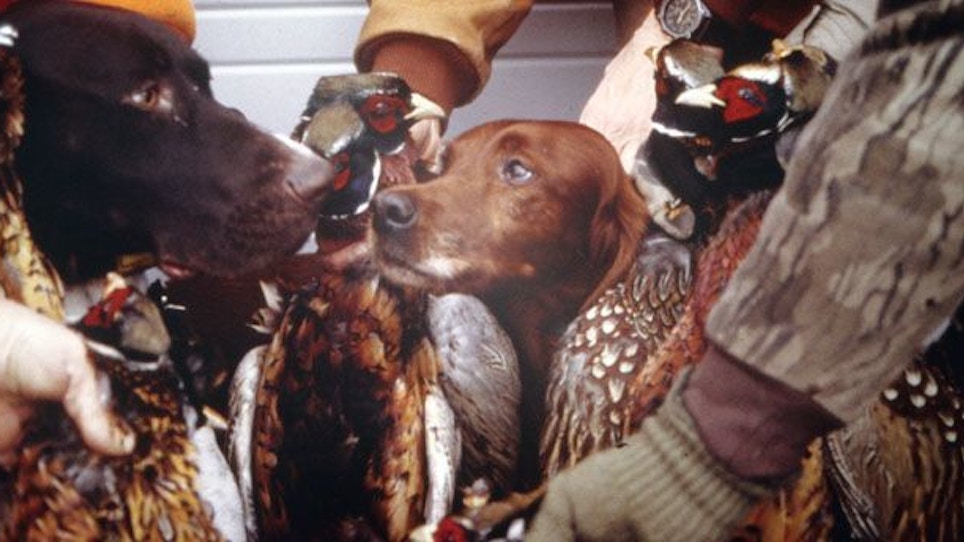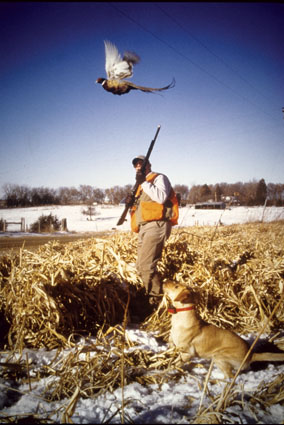 Here are the opinions of three hunting dog magazine editors on the subject of what general qualities are essential for any kind or breed of gun dog used for getting pheasants. And, here are some specific methods used by the top gun dog trainers in the country on how to make your pheasant dog more efficient and effective at putting roosters in your gamebag.
Here are the opinions of three hunting dog magazine editors on the subject of what general qualities are essential for any kind or breed of gun dog used for getting pheasants. And, here are some specific methods used by the top gun dog trainers in the country on how to make your pheasant dog more efficient and effective at putting roosters in your gamebag.
Desire to Hunt Pheasants
"Desire to find pheasants in the field is one of the main factors in making for a good pheasant dog," in the thinking of Rick Van Etten, editor of Gun Dog Magazine. "Though the major theme of our magazine centers on how to better train your gun dog, the best-trained dog in the world won't be the best pheasant dog without a burning desire to hunt for these birds in all types of habitat and in all kinds of conditions," Van Etten believes.
"A dog with aggressiveness is the way Datus Proper described 'desire' in his book Pheasants of the Mind. And, by aggressiveness, Proper meant a canine's wild enthusiasm to find gamebirds of any kind," Van Etten points out. "On a pheasant hunt, most any dog can go along for a walk and maybe stumble across a rooster now and then. But, a good pheasant-finder is one that is on fire with desire to put ringnecks into the air."
Enhancing the Desire to Hunt Pheasants
"You can't 'teach' desire to a pheasant dog. But, you can 'enhance' desire by giving your pointing or flushing dog lots of exposure to ringnecks," according to Jim West, a full-time trainer at Wild West Kennels in Sidney, Iowa. "Every dog owner knows that 'birds make a bird dog,' but not every hunter practices this basic principle," West feels.
"My advise for 'massive exposure' of any dog to gamebirds is to have some training sessions at a hunting preserve using pen-raised, released pheasants," West suggests. "There are commercial preserves located in every state and most operators are open to any customer who would like to buy some pheasants and have them specially put into the field specifically for dog training purposes," West has found.
"Most preserves have lots of birds, good habitat, and a season that typically runs from September 1 to March 31," West says. "And, don't worry about your dog catching tame birds that won't run or fly because most modern day pen-raised ringnecks are genetically produced to be very much like wild birds. Do, however, have control over your dog with a check cord or an e-collar especially as your pointer or flusher quickly develops a burning desire to hunt pheasants," West adds.
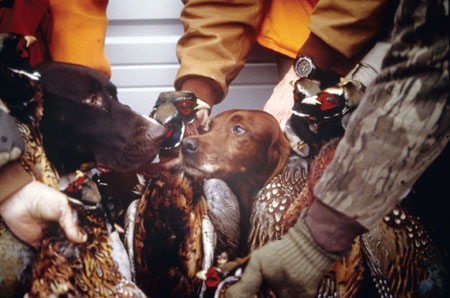 Intelligently Quartering In a Search for Birds
Intelligently Quartering In a Search for Birds
"Any 'good' pheasant dog should have the inborn ability to intelligently search for any gamebirds by quartering through the field in a methodical, but not mechanical, pattern,” in the experience of Steve Smith, editor of Pointing Dog Journal and Retriever Journal magazines. "The emphasis here is on 'intelligence' or the natural ability of a dog to figure out that pheasants can be found by looking in the most likely bird-holding places," Smith believes.
"Instead of running in random directions or erratic circles an intelligent dog, with experience, can develop a regular and purposeful method of covering a field in the quest for game. These dogs have a genetic impulse to hunt this way and these innate traits can easily be improved with training during the hunting season and throughout the rest of the year," Smith believes.
Training to Intelligently Quarter
"Training a pheasant dog to quarter in the field is fairly easy if the dog has the genetics to compel it to do this in the first place," according to Rick Smith. "In the Silent Command training system developed by my dad, Delmar Smith, a half dozen pigeons and later on pheasants are planted in a short-grass field 50 to 100 yards from each other for a distance of 200 to 300 yards."
"The dog being trained to quarter is then brought in on a 75-foot check cord and led in a zig-zag pattern through the field in search of the planted birds. When the pigeons or pheasants are found then pointed or flushed, depending on the breed of the dog, the dog, still under the control of the check cord, is taken toward the next bird," Smith describes.
"When this zig-zag quartering pattern is repeated several times, most well-bred gun dogs will naturally start to hunt every field in this same fashion," Smith has discovered. "Sometimes, in the early years of a dog's training program, a check cord or a remote training collar might have to be used for 'remedial education' and 'tune-up'," Smith suggests.
'Hunt Dead' On Command
"A dog that will 'hunt dead' is one main qualification of a good pheasant dog," in the experience of Dennis Guldan, editor of Bird Dog and Retriever News magazine. "A rooster that flushes, gets shot, then falls into thick cover sometimes can be impossible to find without a dog that hunts a 'dead bird' on command," Guldan believes.
"Even a pointer or retriever that doesn't actually 'see' a pheasant fall in thick vegetation should be willing and able to be brought in to search for that bird… Most all breeds of dogs have the instincts to do this. But, many dogs need some further training and practice to become really proficient at finding dead birds," Guldan believes.
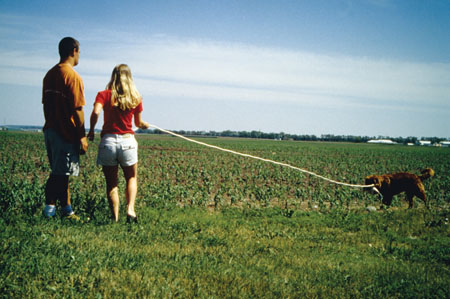 "Some pheasant hunters feel that some breeds of gun dogs won't hunt for or retrieve dead roosters. But, that point of view is pretty much a baseless prejudice… Those who think their particular breed of pheasant dogs won't hunt or retrieve any dead game on command probably haven’t tried to teach the dogs this skill. If these dogs were 'trained' to search for and bring in dead roosters, their owners likely might be pleasantly surprised," Guldan feels.
"Some pheasant hunters feel that some breeds of gun dogs won't hunt for or retrieve dead roosters. But, that point of view is pretty much a baseless prejudice… Those who think their particular breed of pheasant dogs won't hunt or retrieve any dead game on command probably haven’t tried to teach the dogs this skill. If these dogs were 'trained' to search for and bring in dead roosters, their owners likely might be pleasantly surprised," Guldan feels.
Training to 'Hunt Dead'
"Training any good pheasant dog to 'hunt dead' on command for a rooster that has been shot and has dropped into some dense cover is fairly easy," in the opinion of John Luttrell, head dog trainer at Oak Tree Hunting Lodge in Clark, South Dakota. "And most any breed of well-bred bird dog can be taught to find a dead rooster whether they’ve actually 'watched' the bird fall or if they're 'told' to look for a dead pheasant that dropped unseen into some thick habitat," Luttrell has found.
"One efficient and effective way to teach a pheasant dog to 'hunt dead' is to tape some dried out rooster wings to a retrieving dummy either of the canvas or plastic type. Start by throwing this dummy on the lawn in your yard so your dog will get enthusiastic about finding and retrieving it. Next find a field with some knee-high grass and toss the dummy various distances while giving the command 'dead bird," Luttrell suggests.
"Once your dog dependably finds the dummy in the grass on command, go to a cattail slough next to a road so that you and your pooch can see over and into the cover. Now throw the dummy up close then far out each time saying 'dead bird'. After several repetitions, most pheasant dogs will get real good at finding the dummy and eventually dead rosters no matter where you drop them," Luttrell believes.
"Keep the dummy with the taped on pheasant wings in your vehicle at all times so you and your dog can practice the 'dead bird' routine at every opportunity," Lutrell advises. "Or buy Tom Dokken's Dead Fowl Trainer 'Pheasant' which has the look, feel, weight, and size of a real rooster," Luttrell suggests.
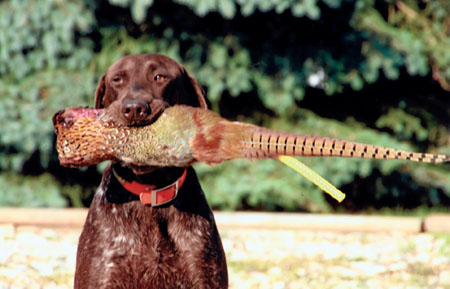 Conclusion
Conclusion
The "good" pheasant dog should have a high level of "desire" to aggressively seek ringnecks in all kinds of cover and in all sorts of conditions. Though this desire can't be taught if it isn't naturally there, innate and inborn desire can be enhanced by training any breed of dog with a mass exposure to live pheasants whether pen-raised and released or found in the wild.
Most "good" pheasant dogs, likewise, should have the ability to intelligently "search" for birds by "quartering" in the field with a methodical, though not mechanical, pattern. Some breeds and lines of pointers and flushers are more inclined to do this than some others. But, all pheasant dogs can be "taught" to improve their search and quartering skills through the careful use of a check cord or an e-collar.
Finding "dead" roosters shot and dropped in thick bird-hiding cover is a big part of a "better" pheasant dog’s job. To hunt "dead" on command in cornfields, cattails, weed patches, tree belts, or CRP is something any breed can do with training and practice on retrieving dummies thrown on the lawn at home or in dense cover out in the country.
A desire to hunt pheasants, a methodical search for ringnecks in the field, and a skill at finding dead roosters are all qualifications many pheasant dogs already have and all pheasant dogs can aspire to. Identifying what your rooster finder now does well and could do better are two steps in the right direction for making your ringneck rouster an even better pheasant dog.
